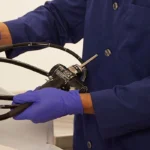National Nurses Week provides an opportunity to celebrate the excellent work done by all nursing teams and staff. It’s also a good time to acknowledge and explore opportunities to improve nurse working conditions.
Inspire, Innovate, Influence
This week, hospitals across the country are taking time to recognize some of their most important employees – the nursing staff. As the face of the hospital, nurses are the linchpin in the continuum of care, and their efforts on the front lines directly impact patient outcomes. Nurses also largely embody the culture of the hospital, and a culture that enables caregivers to spend more time at the bedside plays an invaluable role in the patient’s experience during a hospital stay.
During this year’s National Nurses Week, the theme is “Inspire, Innovate, Influence.” This theme puts the focus on the excellent work and quality care nurses provide every day. Yet, while they signed up for the job to help treat patients, nurses face many barriers. These obstacles affect nurses’ ability to deliver the level of dedicated care they expect of themselves and think their patients deserve.
Fortunately, hospitals can help lessen the strain put on the nursing staff by creating a better environment for patient care. Here are three ways in which hospitals can reduce nurse burdens, increase satisfaction and improve retention.
1. Inspire better patient care by bringing nurses back to the bedside
Arguably, nurses have one of the toughest, most hectic jobs in the hospital. Unfortunately, much of this time can be spent on administrative work and non-value-added tasks. For example, having nurses order, manage and search for medical equipment is an often-overlooked burden placed on the nursing department. And it takes time away from patients.
In fact, the average nurse spends over 20 minutes per shift searching for equipment. Equipment that should be readily available at a moment’s notice, but isn’t. Equipment repair, inspection and cleaning backlogs, and hoarding practices are some examples of why nurses often struggle to find needed medical equipment. If a hospital can reduce that burden on nurses, they will have more time to spend at the patients’ bedsides.
2. Find innovative ways to reduce administrative burdens
As nurses spend more time away from the bedside on non-value added tasks, job satisfaction can decrease. Combined with a high volume of administrative work, nurses can start to feel fatigued and disenfranchised with the role. In fact, today’s turnover rates show that one in eight nurses is expected to leave their job within the year. And it takes an average of 85 days for a hospital to recruit, hire and train a new nurse. In the interim, the current nursing staff is expected to provide the same level of patient care while managing a higher workload.
Because of this, hospitals are faced with the ongoing challenge of retaining their high-value nursing talent while recruiting from a diminishing pool of nurses. Finding a way to bring the focus back to patient care by reducing non-value added tasks and administrative workload can play an important role in nurse retention.
One way to do this is by empowering nurses to make decisions, faster. Nurses can spend a lot of time coordinating with vendors to rent medical equipment, or searching the hospital for their own devices. Some facilities have turned to customized, equipment ordering algorithms to cut down on the time spent accessing the specialized beds and therapy surfaces needed for specific at-risk patient types.
Other hospitals have centralized their equipment management process in order to improve workflows between departments. Having a dedicated team of on-site experts focused solely on the pick-up, cleaning, tracking and delivery of movable medical equipment removes the burden from nursing staff.
Both of these tactics, especially when combined, can improve speed to therapy and cut down on the time nurses spend on non-core tasks. Quick, effective wins like these help position hospitals to attract and retain quality nurses by enabling them to focus more on their patients.
3. Allow nurses to influence the decision-making process
There is an opportunity within hospitals to reduce unnecessary nurse burdens by improving workflows between different departments. The work done and decisions made by supply chain and clinical engineering teams have a direct impact on a nurse’s ability to provide care. The unique and combined knowledge of these three departments can improve workflows. It can also free up nursing staff so they can spend more time at the patient bedside.
If you want to figure out what challenges your nurses are facing, ask them. Nurses know where their departments need help, and their input can lead to improved systems and reduced costs. Giving nurses a seat at the decision-making table can also provide you with access to valuable insights. Insights that can help inform the capital purchasing process and better predict demand based on patient volumes.
You may be asking yourself, “Isn’t the third suggestion adding more nurse responsibility?” Fair enough, but who doesn’t want to be heard? And if a hospital can solve the challenges addressed above, then the suggestion here will likely be welcomed with open arms.
If you are looking for more ways to streamline nurse workflows and limit burnout, download the E-Book, “Reduce Nurse Burdens to Increase Retention.”
Visit our Resource Center to discover more, or learn how an Onsite Managed Program can help.











